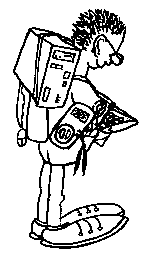5 1/2 DMM from the 80ies. It has a hidden 6 1/2 digit mode. My meter does not have the True RMS module for AC. But it has a connector that emits the measurements via RS232 (not tested).
While all date codes from the digital board are from 1984, I found also some chips from 1988. So the meter is from 1988 or later.
It looks like the meter was in “official” use until 2023, because there is a safety sticker from this year.
This is a great DMM from the around 1979.
It is called “Microvolt Digital Multimeter” because it has a resolution down to 1 microvolts. Even more interesting is the current range, going down to 1nA (nanoampere) resolution.
This is due to the DC range 20 mV (20.000mV) and DC current range 20 µA (20.000µA). Finally, it has a 1mOhms resolution on 20.000 ohms range.
This multimeter is great to measure small currents, e.
When searching for a scheme for a HF probe, I found a good working solution at https://elektronikbasteln.pl7.de/signalverfolger-fuer-nf-und-hf-selbst-gebaut .
The scheme uses two germanium rectifiers and looks like this:
(click to view larger version) My hand drawing, a better image can be found on https://elektronikbasteln.pl7.de/signalverfolger-fuer-nf-und-hf-selbst-gebaut
I tried that HP probe schema with good results. The original uses 2 diodes AA118, I have used AA143.
In the next images, we can see a 25 MHz signal, AM-modulated with a 1 KHz signal.
Since the 1950ies, Heathkit produced tube voltmeters. The Heathkit IM-18D is one of these, more from the 60ies, but I do not know the exact production year of my device. Heathkit sold these devices as kits. So you got all parts and soldered it all together. Also calibration was left to the buyer.
You can compare this tube meter with my Heathkit V-7A, which is about 10 years older but very close…
When buying my Heathkit IM18D (see here), I got this meter for a few more bucks.
It was very dirty and was sold as not working. Also, someone has poured some silver paint over the poor device…
Heathkit V-7A after some cleaning (knobs were in dishwasher when I took that photo)
Some strange kind of line connector was found (this is a DIN connector, and I suppose someone had a cable that was used to put 230 volts in here…)
When entering the area of old tube receiver repairment, I found that a signal tracer device is crucial. With this device, you can trace a signal in the stages of the radio device and identify the stage that is not working anymore, so it is a great tool to troubleshoot radio receivers.
Grundig SV41 signal tracer
Signal tracers are not produced anymore, I think they passed when receivers and amplifiers were designed with ICs, where you have multiple or all stages of an electronic circuit in a single chip.
Having 3 tube radios from 1950 .. 1960ies, I though it’s time to also have a tube tester.
You can have the simple ones, but also a lab level device. All these tube testers come from 1950 .. 1960 years. You can have one for european tubes only or more general ones with american and european tubes. So I decided to get an american version. All modern amplifier tubes are american brand, so this is a good approach.
East german product. With tube technology. From 50ies. Obsolete, Outdated. Unhip?
The root of all this came from Corona agony. I thought: Why not to look again to tube technology?
Device after cleanup and fixing
Last year a friend gave me an old tube radio as a gift. I love the sound of this small Lowe Opta Bella Luxus and handled it like a religious device, e.g. the Bundeslade.
Time passed and I thought: why not getting another tube radio.
Wägezellen sind Kraftsensoren, mit denen z.B. elektrische Waagen aufgebaut werden.
Mit dem Typ “Doppelbiegebalkenfederkörper” habe ich experimentiert.
Wägezellen eines Typs werden für unterschiedliche Nennlasten (z.B. 5, 10, 50, 90 KG) gefertigt.
Einsatzgebiete sind Messsysteme wie Dosierwaagen, Plattformwaagen, Abfüllwaagen.
Meine Wägezellen Modell 1015 Hersteller unbekannt. Dieses Zellenmodell ist eines der ersten industriell gefertigten Modelle überhaupt. Laut http://www.soemer.de/waegezellen/waegezelle-1015.html sind bisher mehr als 10 Millionen dieser Zellen gefertigt worden. Nennlasten im Bereich von 3-90 KG werden angeboten.
